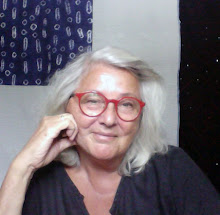 |
| Agnes Martin's Innocent Love 1999 acrylic on canvas series at the Dia Beacon, New York. There are eight paintings in this series, four on each wall. All are 60 inches square. |
Q: How do you start a painting?
A: "I wait for inspiration.
I ask my mind - What am I going to paint next? and it appears in my mind. My inspirations are in colour. "
She uses mathematics to decide the scale and relation of the colours. She draws lines with a small ruler because a big ruler pushes the canvas down.
 |
| Happiness. Innocent Love series 1999 |
Innocence.
"For twenty years I was not satisfied with my paintings and at the end of every year I had a big fire. "
 |
| Love: Innocent Love series 1999 |
Waiting for inspiration.
"I was thinking of innocence, and a grid came into my mind, and so I painted it. 6 feet by 6 feet and I liked it. It looked like innocence. And I asked the museum of Modern Art if they wanted it and they did."
 |
| Contentment: Innocent Love series 1999 |
"Sometimes I take a year off so I'll know something,
because when you're painting, you just get up and do it.
You don't know it."
 |
| Innocent Love series seen through opening, on the facing wall is The Spring, 1958. 48" square |
"Artists are very fortunate. Other working people have to talk to people all day.
You just can't be an artist if you can't be alone.
When you're alone, you are affected by everything.
The sky, nature.. You respond."
 |
| Untitled #16, 2002. The thin paint allows the roughness of the gesso undercoating to be more evident. |
The environment doesn't have impact on my work. I don't paint nature."
 |
| untitled 1959, 30 inches square |
"When I draw horizontals - it's expanding
I like the horizontal line better than any other. It's not related to landscape.
It goes out.
When you look at the painting you go in over the horizontal line.
It's like music.
Some musicians compose music about music.
Beethoven composed music about experience.
Joy.
Happiness.
It has meaning.
Painters can paint about painting, but my painting is about meaning.
I use that horizontal line to get meaning."
 |
| left: untitled 70", 1960 oil, painted when the artist was 48, right: untitled #17,2002, acrylic, painted at 90 years |
Minimalism
"They were non subjective.
No emotions were in the work.
Minimalists tried to be not there.
They wouldn't put their names under the paintings.
They said to write their names with a number.
People call me a minimalist, but I'm not.
I'm an abstract expressionist.
I sign my name on the back."
 |
| The Beach, 6 foot square pencil on white Gesso painting from 1964 - detail. |
Empty mind
"The intellect struggles with facts.
Keep discovering facts, then make a deduction.
But this is just guess work, inadequate.
You won't find out about life.
I gave up facts in order to have an empty mind.
You have to practice an empty mind.
I gave up being intellectual.
I don't have ideas.
I'm convinced that with a soft attitude you receive more."
......................................................................................................
Agnes Martin (1912 - 2004) quotes from Mary Lance's documentary With My Back To The World.
Images are of Agnes Martin's 2012 installation at the Dia: Beacon.
Another excellent interview with Agnes Martin (1997) is here.























